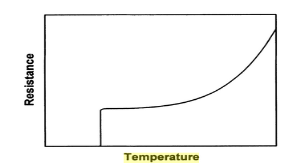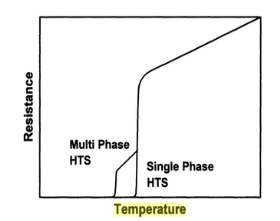Unit - 6
Superconductors
Q1) Explain Low & High temperature (YBaCuO) superconductors.
A1)
Fig. 6.1. Shows resistance versus temperature for a low-temperature superconductor. At the transition Tc, the resistance drops abruptly to a small value. This behavior is different from steadily decreasing resistance of non-conducting super metals and suggests the existence of a physically different superconducting state. In pure semiconductors, the zero-resistance state can be reached within a temperature range of 1mk. In the case of impure metals, the transition to the superconducting state may be broadened.

Fig.6.1 Resistance versus Temperature for a Low-temperature superconductor
Fig.6.2. Shows resistance versus temperature for a single and multi-phase high-temperature superconductor. Bi, Tl, Hg based cuprate superconductors are chemically complex material in which there may exist several superconducting phases in one specimen.

Fig.6.2 Resistance versus temperature curve of a single-phase and multi-phase high-temperature superconductor
Q2) What is Meissner effect? Explain.
A2)
The Meissner effect is the expulsion of magnetic flux upon cooling a superconductor through Tc in a dc magnetic field through upper critical field Hc2 at a constant temperature. Type-II superconductors will not exhibit a Meissner effect if they have good flux pinning in the mixed state. Thus, while a material that has the Meissner effect is a superconductor.
Shoenberg stated that for many of the element superconductors, it has not yet been possible to obtain a specimen which shows a complete Meissner effect. Tantalum a type I superconductor is a case in point that shows the Meissner effect of 1%. For tantalum, the Meissner effect is practically non-existent because the metal freezes in all of the existing flux when it becomes superconducting. Pure tantalum in bulk is made by sintering small flakes or grains. Thus, from a physical point of view, the metal is not homogeneous, and the Meissner effect might not be realized by metal.
Type II elements and alloys and other inhomogeneous superconductors fail to show a Meissner effect. It is experimentally found that in weak fields Meissner effect approaches 100%.
Q3) Give a few applications of Superconductors.
A3)
1. Magnetic levitation is a relevance where superconductors act upon tremendously well. Transport vehicles such as trains can be made to "float" on physically powerful superconducting magnets, in effect eliminating friction between the train and its tracks.
2. An area where superconductors can carry out a life-saving job is in the field of biomagnetism. Doctors need a non-invasive means of determining what's going on within the human body. By impinging a bodily commanding superconductor-resultant magnetic field into the body, hydrogen atoms that stay alive in the body's water and fat molecules are enforced to acknowledge energy from the magnetic field. They then liberate this energy at a frequency that can be detected and displayed graphically by a computer.
3. Electric generators made with superconducting wire are extremely capable than conventional generators wound with copper wire
4. An idealized function for superconductors is to utilize them in the spread of commercial power to cities.
5. Superconductors have also found widespread applications in the military.
6. A superconducting sensor such as SQUIDs (Superconducting Quantum Interference Devices) is used to detect even the weakest magnetic field. They are used in mine detection equipment to help in the removal of landmines.